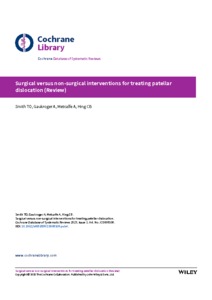Smith, T; Gaukroger, A; Metcalfe, A; Hing, CB
(2023)
Surgical versus non-surgical interventions for treating patellar dislocation.
Cochrane Database of Systematic Reviews, 2023 (1).
: CD008106.
ISSN 1469-493X
https://doi.org/10.1002/14651858.CD008106.pub4
SGUL Authors: Hing, Caroline Blanca
![[img]](https://openaccess.sgul.ac.uk/115094/3.hassmallThumbnailVersion/Smith_et_al-2023-Cochrane_Database_of_Systematic_Reviews.pdf)  Preview |
|
PDF
Published Version
Available under License ["licenses_description_publisher" not defined].
Download (907kB)
| Preview
|
Abstract
Background
Patellar (knee cap) dislocation occurs when the patella disengages completely from the trochlear (femoral) groove. It affects up to 42/100,000 people, and is most prevalent in those aged 20 to 30 years old. It is uncertain whether surgical or non‐surgical treatment is the best approach. This is important as recurrent dislocation occurs in up to 40% of people who experience a first time (primary) dislocation. This can reduce quality of life and as a result people have to modify their lifestyle. This review is needed to determine whether surgical or non‐surgical treatment should be offered to people after patellar dislocation.
Objectives
To assess the effects (benefits and harms) of surgical versus non‐surgical interventions for treating people with primary or recurrent patellar dislocation.
Search methods
We searched the Cochrane Bone, Joint and Muscle Trauma Group's Specialised Register, the Cochrane Central Register of Controlled Trials (CENTRAL), MEDLINE, Embase, AMED, CINAHL, Physiotherapy Evidence Database and trial registries in December 2021. We contacted corresponding authors to identify additional studies.
Selection criteria
We included randomised and quasi‐randomised controlled clinical trials evaluating surgical versus non‐surgical interventions for treating primary or recurrent lateral patellar dislocation in adults or children.
Data collection and analysis
We used standard Cochrane methods. Our primary outcomes were recurrent patellar dislocation, and patient‐rated knee and physical function scores. Our secondary outcomes were health‐related quality of life, return to former activities, knee pain during activity or at rest, adverse events, patient‐reported satisfaction, patient‐reported knee instability symptoms and subsequent requirement for knee surgery. We used GRADE to assess the certainty of evidence for each outcome.
Main results
We included 10 studies (eight randomised controlled trials (RCTs) and two quasi‐RCTs) of 519 participants with patellar dislocation. The mean ages in the individual studies ranged from 13.0 to 27.2 years. Four studies included children, mainly adolescents, as well as adults; two only recruited children. Study follow‐up ranged from one to 14 years.
We are unsure of the evidence for all outcomes in this review because we judged the certainty of the evidence to be very low. We downgraded each outcome by three levels. Reasons included imprecision (when fewer than 100 events were reported or the confidence interval (CI) indicated appreciable benefits as well as harms), risk of bias (when studies were at high risk of performance, detection and attrition bias), and inconsistency (in the event that pooled analysis included high levels of statistical heterogeneity).
We are uncertain whether surgery lowers the risk of recurrent dislocation following primary patellar dislocation compared with non‐surgical management at two to nine year follow‐up. Based on an illustrative risk of recurrent dislocation in 348 people per 1000 in the non‐surgical group, we found that 157 fewer people per 1000 (95% CI 209 fewer to 87 fewer) had recurrent dislocation between two and nine years after surgery (8 studies, 438 participants).
We are uncertain whether surgery improves patient‐rated knee and function scores. Studies measured this outcome using different scales (the Tegner activity scale, Knee Injury and Osteoarthritis Outcome Score, Lysholm, Kujala Patellofemoral Disorders score and Hughston visual analogue scale). The most frequently reported score was the Kujala Patellofemoral Disorders score. This indicated people in the surgical group had a mean score of 5.73 points higher at two to nine year follow‐up (95% CI 2.91 lower to 14.37 higher; 7 studies, 401 participants). On this 100‐point scale, higher scores indicate better function, and a change score of 10 points is considered to be clinically meaningful; therefore, this CI includes a possible meaningful improvement.
We are uncertain whether surgery increases the risk of adverse events. Based on an assumed risk of overall incidence of complications during the first two years in 277 people out of 1000 in the non‐surgical group, 335 more people per 1000 (95% CI 75 fewer to 723 more) had an adverse event in the surgery group (2 studies, 144 participants).
Three studies (176 participants) assessed participant satisfaction at two to nine year follow‐up, reporting little difference between groups. Based on an assumed risk of 763 per 1000 non‐surgical participants reporting excellent or good outcomes, seven more participants per 1000 (95% CI 199 fewer to 237 more) reported excellent or good satisfaction.
Four studies (256 participants) assessed recurrent patellar subluxation at two to nine year follow‐up. Based on an assumed risk of patellar subluxation in 292 out of 1000 in the non‐surgical group, 73 fewer people per 1000 (95% CI 146 fewer to 35 more) had patellar subluxation as a result of surgery.
Slightly more people had subsequent surgery in the non‐surgical group. Pooled two to nine year follow‐up data from three trials (195 participants) indicated that, based on an assumed risk of subsequent surgery in 215 people per 1000 in the non‐surgical group, 118 fewer people per 1000 (95% CI 200 fewer to 372 more) had subsequent surgery after primary surgery.
Authors' conclusions
We are uncertain whether surgery improves outcome compared to non‐surgical management as the certainty of the evidence was very low. No sufficiently powered trial has examined people with recurrent patellar dislocation. Adequately powered, multicentre, randomised trials are needed. To inform the design and conduct of these trials, expert consensus should be achieved on the minimal description of both surgical and non‐surgical interventions, and the pathological variations that may be relevant to both choice of these interventions.
Statistics
Item downloaded times since 03 Feb 2023.
Actions (login required)
 |
Edit Item |


